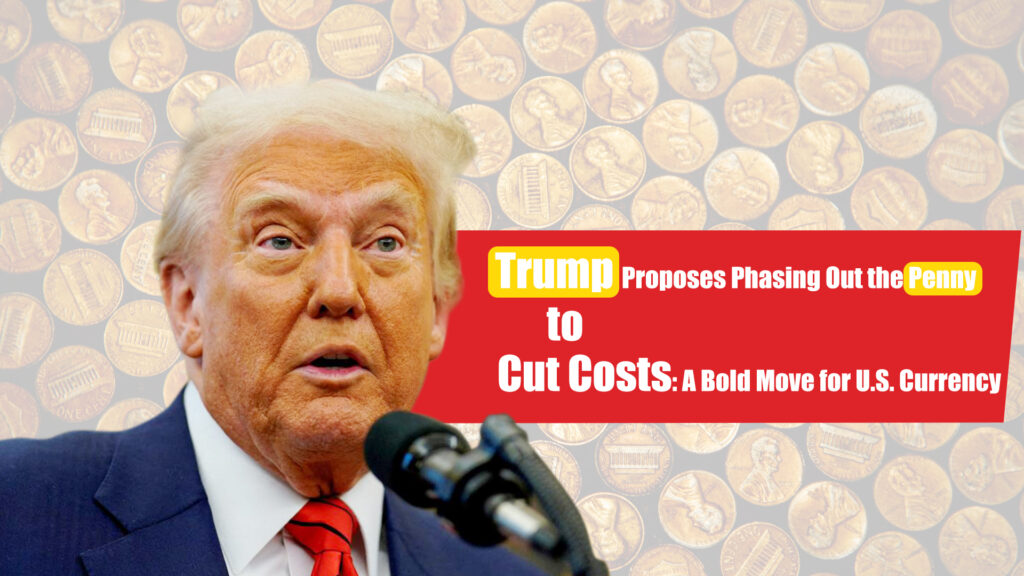
Introduction
In a surprising yet financially motivated decision, former President Donald Trump has announced his plan to halt the production of new pennies, citing high production costs and diminishing practical use. This move has reignited a long-standing debate over the future of small-denomination coins in the U.S. economy. Trump’s proposal is part of a broader initiative to streamline government spending and reduce unnecessary expenditures. If implemented, this could mark a historic shift in how Americans handle everyday transactions.
The Cost of Making a Penny
One of the primary reasons behind this proposal is the cost associated with producing a single penny. Currently, the U.S. Mint spends approximately 2.72 cents to produce just one penny—nearly triple its face value. This discrepancy has led to millions in annual losses for the federal government. Despite being one of the lowest-value denominations, pennies remain in circulation, with billions produced every year. However, as inflation rises and digital payments become more prevalent, the question arises: Is the penny still necessary?
Trump’s Rationale for Eliminating the Penny
During a press conference, Trump emphasized the financial waste tied to penny production. He argued that phasing out the penny would align with his broader economic strategy of cutting unnecessary government expenses.
“We are wasting millions—MILLIONS—every year making pennies that nobody even wants. People throw them in jars, in their cars, or they don’t even pick them up off the ground anymore. We’re going to stop making them. It’s common sense,” Trump stated.
Trump also pointed to other countries that have successfully phased out their lowest-value coins, including Canada, Australia, and New Zealand, without causing significant economic disruption. By eliminating the penny, he believes the U.S. can streamline cash transactions and allocate resources more efficiently.
Public Reaction: Mixed Opinions
The announcement has sparked a diverse range of reactions from both politicians and the general public.
Supporters Say It’s Long Overdue
Many economic analysts and financial experts have backed the proposal, claiming that the penny has outlived its usefulness. They argue that:
- Retail transactions will become faster without pennies slowing down cash exchanges.
- Businesses could save money by rounding transactions to the nearest five cents.
- Government spending on minting coins would be reduced, potentially saving taxpayers millions each year.
Economic expert David Rosenberg stated, “The elimination of the penny is not just a cost-saving measure—it’s a step toward modernizing our monetary system. We’re long overdue for this change.”
Opponents Fear the Impact on Pricing
However, not everyone agrees with the move. Critics worry that eliminating pennies will lead to “rounding inflation,” where businesses round prices up instead of down, effectively increasing costs for consumers.
A spokesperson for the Americans for Honest Pricing Coalition expressed concerns:
“This decision could have unintended consequences. Without pennies, businesses may be tempted to round up to the nearest nickel, increasing overall expenses for consumers, especially those on tight budgets.”
Others view the penny as an American tradition worth preserving. Some sentimental collectors and historians argue that eliminating the penny would erase a small but significant part of the nation’s history.
What Would Happen to Existing Pennies?
A common concern is whether existing pennies will remain legal tender if new ones are no longer produced. According to Trump’s plan, all pennies currently in circulation would remain valid currency and could still be used indefinitely. However, over time, as pennies naturally exit circulation, they would gradually disappear from everyday transactions.
Some analysts suggest that pennies could become collectible items, similar to older coins that are no longer minted. Coin collectors may see an increase in demand for rare or historical pennies, particularly those made before 1982, when pennies contained more copper than zinc.
Lessons from Other Countries
Trump’s plan isn’t without precedent. Several other nations have successfully eliminated their lowest-value coins:
- Canada: Stopped making pennies in 2012. Transactions are now rounded to the nearest five cents.
- Australia: Removed one- and two-cent coins in 1992 without economic disruption.
- New Zealand: Phased out their lowest-value coins in 2006, streamlining their cash system.
These examples suggest that eliminating the penny is not only possible but can be done without harming economic stability.
Potential Alternatives: Digital and Cashless Solutions
With digital transactions dominating modern commerce, many argue that cash—including pennies—is becoming obsolete. Some experts suggest that rather than eliminating just the penny, the U.S. should move toward a fully digital monetary system.
Mobile payments, credit cards, and cryptocurrency are already widely used, making physical coins less necessary than ever. Trump’s plan to eliminate the penny could be seen as a step toward a more modern, cashless economy.
Conclusion: Is This the End of the Penny?
Trump’s proposal to stop making new pennies has reignited an old debate about the role of small-denomination coins in today’s economy. While supporters highlight the cost savings and efficiency gains, opponents worry about inflation and losing a piece of American heritage.
If history is any indicator, eliminating the penny could be a logical step toward streamlining the U.S. monetary system. The coming months will reveal whether this bold proposal gains legislative support or faces resistance from policymakers and the public. One thing is certain: the days of the penny may be numbered.